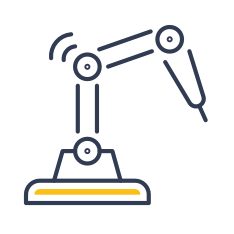A Market Shift from Horizontal to Vertical
In a three-part series, Cisco Investments and McRock Capital are partnering to share their predictions on top trends for the next decade of Industrial IoT. Stay tuned for the next edition.
The implementation of Internet of Things (IoT) has become widespread over the last decade. Before then, Machine to Machine (M2M) communication was the standard for machine connectivity. It started in the 1990s, when low-cost RFID tags were first placed on products to track them through the supply chain. By leveraging innovations in low-cost sensors, connectivity standards, the cloud and big data, IoT became a standard mass-market technology with applications in both consumer and enterprise settings.
Many IoT startups, IT product and service vendors, and industrial solution vendors initially tried to approach Industrial IoT from a more horizontal perspective by combining IoT projects with broader enterprise digital transformation projects, in an effort to find solutions that worked across multiple industries and applications. However, over the past 5–7 years, and after several billion dollars spent on deployments, that perspective has evolved. Today, many have come to understand the wisdom of a more vertical approach for addressing specific customer pain points and use cases in an effort to deliver tailored solutions and measurable outcomes.
The advantages of a “vertical” IoT strategy
Companies with a vertical strategy develop products and solutions primarily for a specific industry which may incidentally apply to adjacent industries. These companies develop deep domain expertise that can accelerate their growth, enhance the stickiness of their solutions and, over time, provide them with a competitive advantage.
When analyzing the flow of investment dollars in IoT, there is strong evidence that vertical Industrial IoT startups are attracting more investors and acquirers. This trend looks to continue for the near term, given the ability of vertical Industrial IoT startups to build a strong line of defense with subject matter expertise, proprietary data, partnerships and products/services that address a real market gap in their respective industry.
Let’s look at some of the investment trends for vertical* and horizontal Industrial IoT startups over the past five years. The total funding for horizontal IoT solutions started strong in 2014 with $787 million* invested across various startups. Over the next three years, dollars invested in horizontal IoT solutions increased steadily, but experienced a sharp decline in 2018 with only $658 million in investments – a decline of 61% compared to the previous year. Total investments in 2019 however are estimated to have hit $1 billion, with few one-off big rounds of late-stage financing, including Samsara ($300 million), SparkCognition ($100 million), C3.ai ($113 million), and RootCloud ($217 million).
By contrast, vertical IoT solutions had a humble beginning in 2014 with about $349 million in total investments, but that number has grown strongly at a 75% CAGR to an astonishing $5.7 billion in 2019, i.e. 5.7x more capital raised than horizontal IoT startups in the same year.
When it comes to acquisitions, horizontal IoT solutions companies witnessed higher acquisition activity over the past few years by virtue of being developed ahead of vertical solutions companies. Cisco’s acquisition of Jasper in 2016 is one such example. However, during 2018-19, M&A activity in the vertical IoT space picked up steam. The acquisitions of Pure Technologies by Xylem, Trafficware by Cubic, and Cisco Investments portfolio companies Relayr by Munich Re and Bit Stew by GE are notable examples.
Why are investors and acquirers more interested in vertical IoT startups, and what does it take to build a leading company in this space? We have some thoughts on that
* Includes IoT companies in Manufacturing, Mining, Oil & Gas, Construction, Agriculture, Logistics and Smart Cities
** Includes Sensor Platforms / Stacks for prototyping/building apps along with software platforms for Network Management, Device Management, Data Management, Analytics and Network Service Providers/Enablers, specifically for IoT applications
*** Source: Pitchbook, Tracxn
There is strong evidence that vertical Industrial IoT startups attract more investors and acquirers.

61%
Decline in horizontal IoT investment dollars from 2017 to 2018

$1B
Invested in horizontal IoT startups in 2019

5.7x
More capital raised by vertical IoT startups vs. horizontal
Key success drivers for vertical IoT companies
Unlike fixed and mobile Internet, IoT is not standards-driven but applications-driven, with different user and buyer personas for any given vertical. Building a vertical IoT solution requires focus on solving a specific problem for specific industries. We see many founders trying to build a vertically focused IoT company with a technology-centric approach rather than a customer-centric approach.
By focusing solely on a customer’s specific needs, a startup can narrow the list of assets to be connected, the types of sensors to be deployed, and/or the data sources to be considered in an effort to train its algorithms most efficiently. For example, Invixium, a McRock portfolio company, zeroed in on a work force management use case utilizing its cloud platform, analytics and biometrics-based access control technology. Using a very specific set of applications, the company managed to significantly influence how organizations within that vertical can manage and track their people. Today, Invixium serves more than 300 customers in more than 60 countries and has achieved significant commercial scale.
A vertical solution usually comes with a well-defined set of supported devices, sensors and software from multiple vendors. Due to lack of device and protocol standardization in IoT, the addition of more software or devices to an existing network may become time consuming and resource intensive. Vertical IoT startups therefore, need to proactively mitigate scalability and lock in issues to succeed. Further, for defensibility of the business, it is key to ensure sustained access to IoT data through proprietary sensors or long-term, contractually secured southbound connections.
Kespry, a Cisco Investments portfolio company that provides drone-based aerial intelligence, first created an autopilot solution for aerial data capture. This autopilot solution had no hardware casing or airframe mounts around it for industrial use case applications. So they built a proprietary drone suitable for industrial data capture. They then went on to build data infrastructure in the cloud to ingest image and video data from the drone to create machine learning-based insights for industrial customers.
Building a vertical IoT Startup in the Industrial space demands a deep understanding of that vertical’s value chain. As most IoT projects remain heavily influenced and funded by operational technology (OT) buyers, a vertical IoT play allows startups to tailor their solution’s value proposition messaging to the key pain points of OT buyers in that vertical. Further, as initial TAM may not be as large as that targeted by a horizontal company, a vertical IoT company should continue to expand TAM over time by extending into more use cases in their focus verticals.
…a vertical IoT company should continue to expand TAM over time by extending into more use cases in their focus verticals.
Veniam, a Cisco Investments portfolio company, demonstrates how to do this. The company started as an intelligent mesh networking solution for vehicles and has gradually expanded to become a platform that enables applications and services to access a vehicle’s data, communications and computing resources with the right QoS and security.
We cannot emphasize enough the importance of domain knowledge for a successful vertical IoT play. Selling these products requires trust and relationships within the industry. Teams that combine technical and subject matter expertise are better able to use outside-the-box thinking to model the domain and drive innovation because they have a thorough understanding of what the box actually is.
McRock Capital invested in one such company, Decisive Farming. The founding team leveraged its deep domain expertise in agriculture, process management and analytics to develop an integrated platform that became the operating system of their customers’ farms. By knowing the various stakeholders and addressing the pain-points across the value chain, Decisive Farming expanded its platform’s offering to three core farm functions: Farm Management – to improve performance, Precision Agronomy – to increase yield, and Crop Marketing – to grow farmer revenue.
As strong as the market potential is for vertical Industrial IoT startups, there is still a strong upside for those startups taking a horizontal approach.
We cannot emphasize enough the importance of domain knowledge for a successful vertical IoT play.
Key success drivers for horizontal IoT companies
Can Industrial IoT startups be purely technology-driven as opposed to customer-driven? The answer is yes, but it requires that they target use cases that occur across verticals, such as connectivity, security and data infrastructure, or that they build an incredibly strong technical team which is capable of architecting solutions that are useful in multiple industries. Examples of this include Mnubo, a McRock portfolio company which was acquired by Aspentech, and Sentryo, which was acquired by Cisco.
If a startup decides to follow a horizontal approach, there are two ways to differentiate: one is to focus on the democratization of the base technology, and the other is to create a strong community around consumers of that technology. To execute on the latter, horizontal IoT startups need to have robust northbound APIs and logic-building platform capabilities to differentiate themselves and allow adoption across verticals.
IoT is a convergence of markets, sub-markets and ecosystems. This fact makes it difficult for horizontal IoT startups to appeal to the multitudes of buyers and value chain stakeholders when going it alone. It is imperative for horizontal IoT startups to partner with other horizontal vendors – in different parts of the tech stack – as well as vertical IoT companies, to deliver holistic solutions to customers.
This is also an area where strong incumbents such as Rockwell, Schneider Electric, and Honeywell have deeply embedded solutions, so startups need to find a specific capability to compete with incumbents and capture value. In terms of untapped opportunities, we see immense potential for horizontal IoT startups to innovate in areas like security, wireless connectivity (5G, Wi-Fi 6 and CBRS; read more here), edge computing and analytics.
…horizontal IoT startups need to have robust northbound APIs and logic-building platform capabilities to differentiate themselves and allow adoption across verticals
What’s next for vertical and horizontal IoT companies?
The past decade was more about building the blocks of Industrial IoT at a time when the horizontal-approach strategy made more sense. At that stage, IoT was a technology looking for a market. Today, practically every industrial market looks to IoT for customer-centric solutions. Going forward, startups that take a vertical approach to these solutions will continue to attract a growing share of customers, investors and acquirers.
For world-class IoT companies focusing on horizontal solutions, areas like connectivity, security and data management remain attractive and will continue to offer scaling opportunities. However, they are not the end goals, but rather the foundation of a path toward something greater.
Interested in learning more about Cisco Investments & McRock Capital?
If you are an IoT startup and would like to partner with us to build the next-generation of solutions, reach out to McRock Capital and Cisco Investments.


